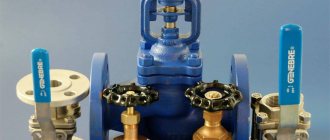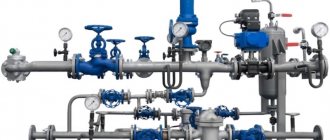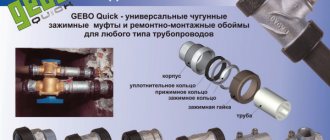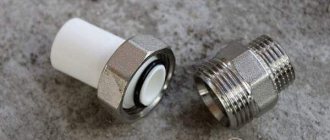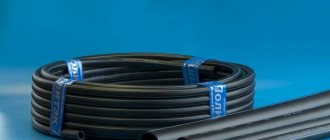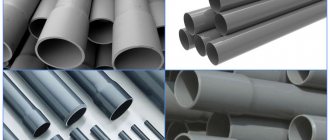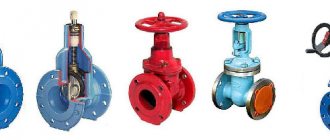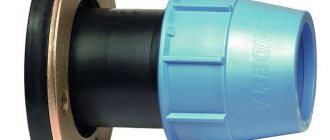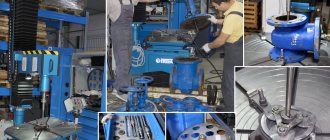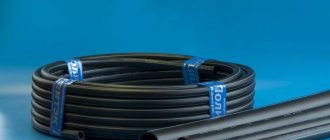Couplings for reinforcement are an assembly element that replaces welding or fastening of rods with binding wire. By type they are divided into two main groups: threaded and crimped. This connection method is innovative. It simplifies the assembly process, allows you to eliminate defects and build up additional areas. With strict adherence to technology, it ensures the reliability of the finished structure.
The coupling connection of the reinforcement does not require the additional use of fasteners and reduces the installation time of the reinforcement cage. The affordable price allows them to be used even for low-rise construction.
Couplings for reinforcement - an assembly element that replaces welding or fastening of rods with binding wire
What it is?
The technology for assembling products from reinforcing bars involves the use of couplings. This ensures savings in rolled metal.
There are two main types of couplings:
- threaded (screwing on the connecting reinforcing bars is required);
- crimping (requires special equipment for crimping).
Each group includes several subtypes of couplings, differing in design nuances and joining methods. Installation using threaded couplings ensures strength and less material consumption (savings up to 20%). Unlike the strapping method, it does not increase the reinforcement structure.
Elements are used to directly connect parts. A reliable, cost-effective option for mounting the frame is provided. Standard sizes of couplings, types and parameters of materials used are regulated by GOST 10922-2012.
Connecting reinforcement using a coupling
Features and purpose
Couplings are often used in combination with other fastening or locking elements:
- limiters;
- valves;
- valves.
The couplings create a high-quality connection because they are made of a material of the same strength as the reinforcing bars.
Scope of application of couplings:
- installation of reinforcement cages during the construction of foundations;
- assembly of metal frames during the construction of multi-story and low-rise buildings, bridges, industrial buildings, power plants.
Couplings for connecting reinforcement are used for fragmentary elimination of joints.
Types of couplings for connecting reinforcement
Today, the main method of connecting reinforcement with couplings has been standardized for use on the territory of our country, represented by a coupling system that makes it possible to fragmentarily eliminate joints on rebar by replacing them with coupling connections of reinforcement.
Couplings for connecting reinforcement are used in all areas of construction. The joining of reinforcement with couplings is being introduced on a large scale into modern structures and eliminates any disadvantages of welding the assembly of the structure, knitting reinforcing pins and a crimp coupling.
The specificity of connecting reinforcement with couplings is innovation, which is widely in demand in the construction of multi-story buildings, hydroelectric power stations, bridges, and nuclear power plants. When connecting reinforcement with couplings, any mechanical damage to the structure is excluded. This is why coupling connections for reinforcement have recently become so popular.
Operating principle and design
Depending on the type, couplings have their own design features and methods of application. Small diameter pipes are used to produce couplings. Inside there is a smooth surface (for crimping types) or a pipe microthread with an inch pitch is applied. The outer connecting end is made in the shape of a polyhedron. Threads are created in various ways: rolling, stamping, etc.
Connecting couplings for fittings
The edges of the connected rods are placed inside the coupling, after which they are joined end-to-end by screwing onto the thread and secured with studs. Position couplings are used to connect reinforcing bars of different diameters. They are used for direct and transverse connections of straight or curved reinforcement. The cost of assembling the structure is included in the planning and preparation of the general estimate.
Advantages and disadvantages
Couplings for structural connection of reinforcement have the following advantages:
- multifunctional connection of metal elements in different directions (horizontal, vertical or inclined arrangement);
- the crimp design of the couplings provides a uniform connection by crimping the ends (does not require preliminary threading);
- the construction time of a monolithic structure is reduced;
- the metal frame can be mounted regardless of the parameters of the structure being constructed;
- ease of design quality control;
- no welding work is required, including highly qualified welding;
- the cross-section of metal reinforcement has a small area;
- the load is distributed evenly over the entire area of the structure being constructed;
- for assembling reinforcing elements of metal frames, special tools and equipment are not required (in the case of threaded couplings);
- there is no need for a limit on the coupling connection of the pins.
As a result, the entire structure is a single metal pin. The frame retains its integrity even if the concrete structure is destroyed.
Mechanical connection of reinforcement using a coupling
Disadvantages of a coupling connection:
- reduction in strength and reliability of installation during thread cutting (reduces the overall thickness of the structure);
- screwing on a coupling with an internal gasket requires some physical effort.
The greatest difficulty is the use of crimp couplings. Application features include:
- increase in the weight of the mounted structure;
- the use of heavy hydraulic presses during the installation process;
- the impossibility of repeating the connection even for one casting of rolled metal;
- the deformability requirement is not met.
Crimping fittings is a technology that has disadvantages. Among the main ones is the inability to maintain the declared quality level when operating conditions change.
CONNECTING COUPLERS FOR FITTINGS
Couplings for fittings. Conical couplings. Crimp couplings. Lenton couplings. A12 couplings.
Until recently, the solution for connecting metal reinforcement bars was using the lap lashing method. Despite the long-term use of this technology, it has a number of negative aspects that negatively affect performance characteristics during operation. The most important is the transfer of load to concrete and when the concrete fails at the joint, the strength is significantly reduced. This is especially evident during corrosion of reinforcing bars. The reinforcement increases in size, concrete separates from the metal, which leads to a complete failure of the connection.
Another negative point is the larger volume of reinforcement at the joints, which:
— leads to overuse of fittings;
— does not allow the use of design solutions with a smaller cross-section of concrete load-bearing structures (columns, floors). This entails additional consumption of concrete and, as a consequence, an increase in the mass of structural elements.
| BRAND | PROPERTIES, APPLICATION | |
| Coupling connections | ||
| CXL (A,B,C,D) | Mechanical couplings with parallel threads. Couplings are designed for transverse connection of load-bearing reinforcement. They have the smallest overall dimensions, while at the same time ensuring an equally strong connection of building reinforcement. Diameters of connected fittings – 12; 16; 20; 25; 28; 32; 36; 40; 50. Options for couplings with transition cross-section diameters are possible. | |
| TTS | Mechanical couplings with tapered threads are designed for use in the vast majority of applications where it is necessary to connect reinforcing bars. The couplings are designed for installation on rods with a diameter of 12 to 50 mm. | |
| MBT | Threadless mechanical couplings The reinforcement is secured inside the coupling using two friction linings and as the shear bolts are tightened, their tapered ends cut into the material of the rods. MVT couplings are especially convenient in cases where the reinforcement is already installed in the structure. Diameters of fittings, mm -10;12;14;16;18;20;22;25;26;28;30;32;36;40 | |
Couplings for fittings. Advantages.
Today, in the field of monolithic construction, technologically reliable solutions with coupling connections for load-bearing metal reinforcement are increasingly in demand. Such solutions have undeniable advantages, including:
• A connection using couplings behaves as a single rod, regardless of the condition of the concrete;
• No highly qualified welding work is required;
• The cross-section of metal reinforcement at joints has a significantly smaller area compared to welding and ductile overlapping reinforcement;
• By ensuring equal strength connections, the construction time of monolithic structures is significantly reduced;
• Costly crane operating time is reduced;
• Reinforcement thickening is reduced, concrete compaction is improved;
• Mechanical connections are ideal for quick and easy installation of reinforcement when using sliding or walking formwork.
• Possibility of increasing reinforcement in the future without losing the quality of connections (relevant when work is stopped or “frozen” at the facility);
Couplings for fittings. Technologies.
There are two technologies for mechanical couplings for valves.
1. Coupling connections for fittings with thread cutting.
2. Crimp couplings with crimping.
Coupling connections for fittings with thread cutting.
Coupling connections with thread cutting are divided into connections with conical and parallel threads. Couplings with conical threads at the ends of reinforcing bars are most in demand at general construction sites. To apply this technology, mobile cutting machines are used that do not require complex training. The machines can be placed directly on the construction site itself, which ensures mobility and speed of work. The technology of couplings with conical threads is owned by such eminent foreign companies as: LENTON (Lenton), ANCON (Ancon), as well as some Russian companies.
Each company has its own threading angle for the coupling connection; therefore, conical couplings from one manufacturer are not suitable for the threading technology of another company. This circumstance should be taken into account when carrying out work on projects.
Coupling connections with parallel threads are used in facilities with increased requirements for reinforcement connections. As a rule, these are objects of the energy complex (hydroelectric power plants, nuclear power plants, etc.). When making connections with parallel threads, foreign manufacturers use a set of machines included in a single technological process, including forging, cutting and subsequent tempering, relieving internal stresses in the rods. Couplings with parallel threads have smaller overall dimensions and a smaller cross-sectional area than couplings with tapered threads with the same diameters of the reinforcement being connected.
Crimp couplings
The technology for connecting reinforcement with crimp couplings does not require equipment for cutting threads, either on the rods or on the coupling itself. The coupling is a simple hollow cylinder. However, to create a connection, hydraulic equipment is required to compress the coupling with the need to deform it. The disadvantage of this technology can be considered the large cross-sectional area of the coupling connection, as well as the inability to bring hydraulic equipment into places where there is a high density of reinforcement. However, the speed of creating a connection with this technology is minimal.
| BRAND | PROPERTIES, APPLICATION | |
| Coupling connections | ||
| RECO | Mechanical couplings with parallel threads. Standard, transition, end anchors, as well as any solutions for connecting reinforcement Diameters from 16 mm to 40 mm. | |
| RECO | Mechanical couplings with parallel threads. Standard, transition, end anchors, as well as any solutions for connecting reinforcement Diameters from 16 mm to 40 mm. | |
| Machine for rolling parallel threads. Can be purchased as property or rented. | ||
| MKC | Mechanical couplings for tapered threaded rebar are designed for use in the vast majority of applications where rebar connections need to be made. Couplings are designed for connecting rods with a diameter from 12 to 40 mm. | |
| MCP | Mechanical couplings for reinforcement with tapered transition threads are designed for cases in which it is necessary to connect reinforcing bars of different diameters. The couplings are designed for connecting rods with a diameter from 12/14 to 36/40mm. | |
| Crimp coupling | Crimp couplings for fittings for subsequent mechanical crimping. The couplings are designed for installation on rods with a diameter of 10 to 55 mm. | |
| YOU MAY ALSO BE INTERESTED IN: |
| • Reinforcement systems for monolithic frame construction |
| • Brackets for curtain wall systems |
| • Brackets for three-layer masonry with an outer layer of facing bricks |
| Dear Clients! We provide our partners with timely deliveries from the factory plus special facility discounts directly, without intermediaries! In addition, by purchasing reinforcing couplings from our company, you receive the following undeniable advantages: You are collaborating with a reliable and experienced supplier, operating on the market since 1995. We are ready to help with design and calculations, including non-standard application units, and carry out installation. Prompt shipment/delivery (average delivery time in Moscow and the region is 1 day, in the regions - 2 - 4 days). Request a special price for couplings |
Types of coupling fastenings
Coupling connections involve various options for joining reinforcing bars:
- couplings with conical thread type;
- parallel thread couplings;
Coupling connections for Ancon MBT fittings
- bolt type couplings;
- crimp couplings for fittings.
Couplings designed for connecting metal structures have several varieties:
- transitional (for sequential joining of rods having different diameters);
- bolted (for connecting reinforcement using special friction linings);
- positional (for high-speed connection of reinforcement of various shapes: straight, curved and curved rods).
If couplings without threads are required, crimp options for connecting reinforcement are mounted from steel pipes.
Types of fastenings
To fix the rods and prevent loosening of the structure, threads are made inside the couplings or crimp rings are installed. According to the type of fastening on the rod, couplings are divided into 2 types:
- threaded, with a thread applied inside;
- crimp, implying the additional use of tightening elements (rings or nuts).
For each method, appropriate preparation and processing of materials is provided.
Threaded couplings
If threaded installation technology is used, couplings with applied threads are used. At the end of the reinforcement there is a thread with an appropriate pitch. Thus, correct fixation is ensured, and the connected rods are no worse in strength than solid ones.
Threaded technology is optimal for reinforcement with a thickness of over 16 mm.
The thread type can be conical or straight. With straight threads, the cylinder size is minimal. The type is determined during the preliminary preparation of the reinforcement. The rod ends are threaded, which must match the thread of the coupling.
During professional threaded installation, rods up to 20-30 meters in length are assembled without segmentation. In this case, no additional elements or wire are used. To fix it, you just need to prepare the joints of the reinforcement and screw it into the coupling. Threaded fastening is a low-cost and easy-to-use method.
Bolted reinforcement couplings
For equal-strength installation of reinforcement without preliminary preparation of the ends, bolted couplings are used. The design includes the following elements:
- cylindrical metal tube with holes for bolts;
- shear bolts;
- screwing tool.
The bolt system is universal. It is applicable to reinforcement of any thickness and shape, smooth and profile. This type of fastening is used for the reconstruction of monolithic buildings.
Crimp fittings
Hydraulic equipment is required for operation. The coupling rods may have an internal partition. They thicken the joints somewhat, but at the same time, ensure quick installation.
Coupling design
Mechanical couplings have the following design features:
- couplings with conical threads are manufactured on mobile threading machines;
- couplings with parallel threads have smaller dimensions compared to other varieties;
- The crimp coupling does not require special equipment to form threads.
Crimp couplings require subsequent mechanical pressing of each joint. Couplings are made from small-diameter pipes, due to which the finished joint is slightly thickened.
Crimp couplings require subsequent mechanical pressing of each joint
Advantages of coupling connections
Crimp couplings for fittings, as well as coupling threaded structures, have a set of positive aspects, the main ones of which are:
- the ability to connect rods located in space at any angle of inclination;
- high intensity of assembly using special connecting devices;
- the identity of the joining process, the quality of which is guaranteed by the technology and design of the connectors;
- absence of increased consumption of reinforcing bars, which was present in the overlap connection;
- possibility of unlimited use of connecting blocks;
- simplified joint quality control using visual methods that control the relative elongation of the coupling;
- maintaining the integrity of the reinforcement frame, regardless of the state of the concrete mass;
- saving financial resources due to the lack of need for qualified welders;
- absence of dangerous sections and uniform distribution of strength along the length of the rod;
- reduction in the construction time of objects, ensured by the characteristics of the equipment used, and not by the qualifications of the builders;
- the use of universal devices for cutting threads using stamping or rolling.
The costs of providing the required number of joints, the timing of the work, the need for labor and the required number of rods are determined at the design stage.
A set of advantages provides this method of joining reinforcement with a leading position compared to other previously used methods of connecting rods. Crimping couplings for reinforcement have proven themselves to be a simple and effective means used in the construction of modern monolithic frames.
Features of the application of innovative technology
The innovation of using a coupling connection is that it provides better quality compared to a welded connection.
Advantages of using couplings:
- does not require complex welding equipment;
- material costs for the construction of joints are reduced;
- the speed of connecting reinforcing bars increases up to 10 times.
An equal-strength connection of rods increases the nominal strength of the reinforcement. This joining method does not affect the strength of the reinforcing bar.
Features of the technology
The coupling connection of the reinforcement represents the sequence of the following operations:
- Installation of crimp elements on reinforcing bars at the joint.
- Pressure testing of the coupling using a hydraulic device.
- Checking the assembly quality using visual inspection.
- Comprehensive quality control of the assembled structure.
Compliance with technology and the use of special crimping devices for mechanized joining makes it possible to correctly fix the elements and guarantee the strength and durability of the reinforcement structure.
Mechanical joining is used to quickly secure connections. The process of attaching two rods takes about 5-10 minutes. During this time, threads are cut at the ends of the rods, centering and screwing of the coupling using a torque wrench. This type of connection simplifies quality control of joints.
Installation technology
The algorithm for installing a metal frame using couplings includes several stages.
- The coupling is installed on a pre-marked reinforcement section.
- The holes of the couplings with internal threads are closed with plastic caps.
Coupling installation technology for connecting reinforcement
- The ends of the cut reinforcing bars are covered with rubber caps. For threaded couplings, threads are cut or rolled on the rods.
- Before putting the coupling on the rod, tighten the connection with a wrench.
When connecting with crimp-type elements, special equipment will be required. Technology includes:
- assembly of crimping devices on rods;
- pressing of units using a portable hydraulic press.
Afterwards, a visual inspection of the connections is carried out and their quality is controlled.
Results
Joining reinforcing bars with special couplings is an optimal alternative to assembly using the overlap method or welding. This technology simplifies the frame installation process and ensures durability.
Mechanical elements are divided into two main groups: threaded and crimped. Each of them has several subspecies, which have their own manufacturing and installation features.
When using connecting elements, you need to know how corner reinforcement and reinforcement of a pile-strip foundation are carried out. You already know the answer to the question whether it is possible to weld reinforcement for the foundation, as well as the nuances of manufacturing reinforcement cages.
Assembling a metal frame reduces the labor intensity of the process and is used to build up or correct structural elements in the future. There is also an alternative option - plastic reinforcement: the pros and cons of using this material will be interesting to know for those who start construction on their own.

